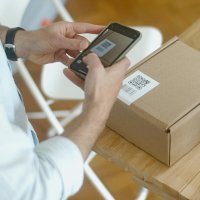What Is a Shipping Barcode and Why Does Your Package Need One?
 Since their invention in the 1950s and wide introduction in the 1970s, barcodes have become ubiquitous; they can be found on all kinds of goods, various documents, identification wristbands, airline luggage, tickets, some types of mail, etc. Barcodes found on mailpieces are typically referred to as shipping barcodes. Why do packages need a shipping barcode and where can you get one for your package?
Since their invention in the 1950s and wide introduction in the 1970s, barcodes have become ubiquitous; they can be found on all kinds of goods, various documents, identification wristbands, airline luggage, tickets, some types of mail, etc. Barcodes found on mailpieces are typically referred to as shipping barcodes. Why do packages need a shipping barcode and where can you get one for your package?
First of all, let’s figure out what a barcode is and how it works. A barcode is a method of encoding data and representing it in a visual, machine-readable form. The oldest and most common type of barcode, called a linear or one-dimensional (1D) barcode, consists of alternating parallel lines and spaces of various widths and sizes that create specific patterns.
Printed barcodes can be read and decoded by special barcode scanners, also known as barcode readers. Like any optical scanner, a barcode reader consists of a light source, a lens, and a light sensor that translates optical impulses into electrical signals. When a barcode scanner shines light on a barcode, the black lines and white spaces of the barcode reflect it differently. The barcode sensor captures the reflected light in the form of an analog signal, which is converted into a binary digital signal. Then a software application decodes the signal and translates it into information encoded in the barcode.
A shipping barcode contains information required to identify and track a shipment as it moves through the delivery chain such as the recipient’s name and address, tracking number, and other relevant details. These codes are usually generated by postal/courier companies and printed on shipping labels that are affixed to packages. Most shipping carriers use 1D barcodes (either Universal Product Code/European Article Number or Code 128) because they are quick and easy to scan, but some use newer two-dimensional (2D) barcodes like QR or Data Matrix codes.
When a package is shipped, a postal employee scans the barcode to add the package into the tracking system. Then the package is scanned at every sorting facility along the way, and the information about its whereabouts and status is updated in the tracking system. This allows senders and recipients to track their packages through the delivery chain, from the point of origin to the final destination.
A shipping barcode is generated by the carrier when you ship your package from the carrier’s office or create a shipping label online on the carrier’s website or via a third-party shipping label printing service such as PostageMaker. Carrier-issued shipping labels are usually printed on self-adhesive paper, but when you print shipping labels yourself, you can use a regular inkjet or laser printer and office paper, and affix the label to the package using clear tape.
If you want your package to arrive to its destination without any trouble, you need to make sure that the shipping barcode is clear and scannable to prevent scanning errors. The label must not be too pale or smudged, so make sure that your printer has enough ink or toner, and let the ink dry before affixing the label when using an inkjet printer.
When you attach the label to the box, smooth out all any creases and wrinkles; do not place the label over a seam or bend it over the edge of the box. If you use clear packing tape to affix the label, do not tape over the barcode because the reflective surface of the tape might mess with barcode scanners.
So, let’s sum everything up. A shipping barcode is a package identifier that allows to record and track your package’s whereabouts. It is generated by the shipping carrier and printed on the shipping label, regardless of whether you have your packages shipped at a post office or print shipping labels and mail packages on your own.